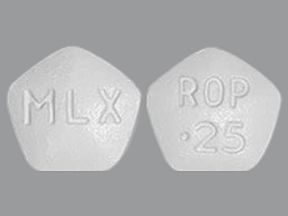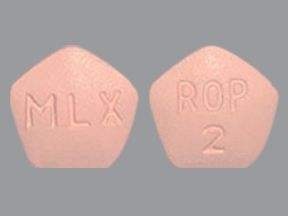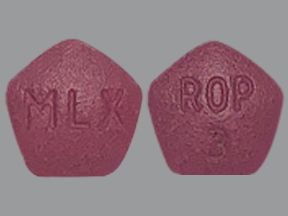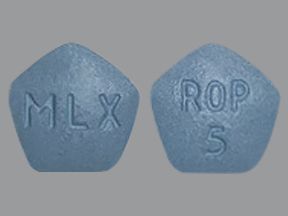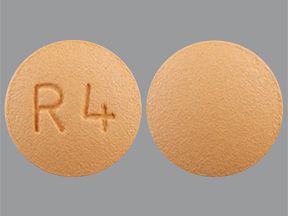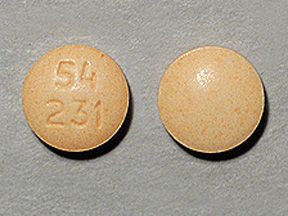Ropinirole is a prescription medication used for the treatment of movement disorders. It works by mimicking dopamine in your brain.
This medication is taken orally and is available in both immediate-release and extended-release tablets. Extended-release medications are released into your bloodstream more slowly throughout the day, while immediate-release medications take effect more quickly.
Ropinirole was previously sold under the brand names Requip and Requip XL. Both brand names have since been discontinued due to business reasons, rather than safety. Ropinirole is still available in generic formulas.
Depending on your treatment plan, this medication may be used as part of combination therapy. This means you would take ropinirole with other medications, as directed by a doctor.
Read on to learn more about ropinirole, including its uses and potential benefits, as well as the possible risks and side effects you should discuss with a doctor.
Taking ropinirole may cause side effects. Clinical trials showed side effects ranging from mild to severe associated with ropinirole.
It’s important to discuss possible side effects with a doctor before taking this medication. If you experience side effects after taking this medication, let the prescribing doctor or a member of your care team know.
Common side effects
The most common side effects associated with ropinirole include:
- significant drowsiness and sleepiness
- involuntary movements in your face and body known as dyskinesia
- nausea
- dizziness
- confusion
- trouble concentrating
- hallucinations or seeing or hearing things that are not real
- temporary memory loss
- headache
- flushing or warm, red skin
- dry mouth
- sweating
- chest pain
- edema, or swelling
- back pain
- high blood pressure
- low blood pressure, which can cause fainting
- indigestion, which can cause bloating, heartburn, and gas
- heart palpitations
- edema or swelling in the legs
- insomnia
- increased infections
- vision problems such as blurry vision or double vision
Mild side effects may go away on their own. But if they’re more severe or don’t go away, talk with a doctor or pharmacist. Some side effects, such as sleep disorders and indigestion, may still be experienced during the maintenance phase of taking the medication.
Severe side effects
While sudden drowsiness or sleepiness isn’t always harmful on its own, it can become dangerous if you’re in the middle of activities or operating heavy machinery when it occurs. This could increase your risk for falls or accidents. Some people taking ropinirole experienced severe somnolence after 1 year of taking this medication.
Additionally, there are other potentially severe or life threatening side effects that can warrant a call to 911 or your local emergency services right away. Those side effects and their symptoms may include the following:
- fainting or loss of consciousness
- heart rate changes, especially if you have a history of heart disease
- low blood pressure that leads to falls
- high fever
- muscle tightness
Other severe side effects may be psychiatric in nature. You should communicate with the doctor who prescribed your medication if you experience symptoms such as:
- hallucinations
- paranoia, or increased suspicion and distrust of people
- significant confusion
- aggressive behavior
- increasing agitation
- intense urges, such as those related to gambling, shopping, binge-eating, or sex
Ropinirole can also bind to melanin in the skin, according to animal studies. This may possibly increase the risk of melanoma, a serious skin cancer. See your doctor if you notice any rapid changes in size, shape, and color of any moles on your skin.
Be sure to follow the doctor’s instructions for taking ropinirole and any other medications. Your dosage may vary.
Uses
Ropinirole belongs to a class of drugs called dopamine agonists. These have the same effect in your central nervous system as the natural chemical dopamine. Ropinirole is primarily used in the treatment of movement disorders, including
The body needs dopamine to help control movement. In diseases such as Parkinson’s, the cells that produce dopamine die. Ropinirole works by acting in place of the missing dopamine without having to be converted.
Before use
The exact dosage and dosing instructions for ropinirole may depend on the following factors:
- the condition being treated
- how severe the condition is
- your age
- other medical conditions
Tell your doctor about any side effects you experience after the initial dose and whether you have experienced any adverse effects from other medications you’ve taken.
Dosage
Ropinirole is taken daily by mouth. To work effectively, the medication must be swallowed whole — do not crush or divide the tablets.
You can take ropinirole with or without food. However, taking it with food may help prevent an upset stomach.
If you need to stop taking this drug, a doctor will slowly reduce your dosage, usually over the course of 7 days. Do not stop taking ropinirole suddenly, and do not change your dosage without talking with a doctor.
The prescribing doctor will provide specific dosing information related to your condition. Below are the general guidelines for this medication.
Parkinson’s disease
For Parkinson’s disease treatment, a doctor may prescribe ropinirole in 2-milligram (mg) doses daily for 1 to 2 weeks. Depending on medication response and side effects, the dose may be increased every week in 2-mg intervals per day.
The doctor may also initially prescribe immediate-release tablets. They may switch you to extended-release tablets as you respond to the medication. The maximum dose per day (daily) is 24 mg.
Restless legs syndrome
If taking ropinirole for restless legs syndrome, your doctor will start you on a daily dose of 0.25 mg. For best results, take the medication 1 to 3 hours before bedtime.
Depending on your response to the medication, your doctor may gradually increase your dose according to the following intervals:
- Days 3 to 7: 0.5 mg per day
- Week 2: 1 mg per day
- Week 3: 1.5 mg per day
- Week 4: 2 mg per day
- Week 5: 2.5 mg per day
- Week 6: 3 mg per day
- Week 7: 4 mg per day
In renal disease
Ropinirole may be initially prescribed in doses of 2 mg daily if you have renal impairment. If you receive dialysis, the maximum dose per day (daily) is 18 mg.
How to handle a missed dose
It’s important to take ropinirole daily, as prescribed by your doctor. If you miss a dose, the medication may not work as well, or it may stop working completely. For this drug to work well, a certain amount needs to be in your body at all times.
If you do miss a dose, take ropinirole as soon as you remember. However, if you remember just a few hours before your next scheduled dose, take only one dose. Never try to catch up by taking two doses at once. This could result in dangerous side effects.
Storage and disposal
Keep ropinirole at room temperature, between 68 and 77°F (20 and 25°C). You should also keep this medication away from moisture and light. Be sure to store the tablets in their container and seal the lid tightly after each use.
If you need to dispose of unwanted or unused ropinirole tablets, ask a doctor or pharmacist, or search for local medication take-back programs. Never throw away your medications in the trash or flush them down a toilet.
Taking ropinirole may cause some unintended effects, such as allergic reactions.
Allergy warning
Ropinirole can cause a severe allergic reaction, which may cause symptoms such as:
- trouble breathing
- trouble swallowing
- swelling of your tongue, lips, face, or throat
- rash
- hives
If you develop these symptoms, call 911 or your local emergency services, or go to the nearest emergency room.
It’s also important to avoid taking ropinirole if you’ve had a previous allergic reaction to it.
Pregnancy and breastfeeding
Talk with the doctor if you’re pregnant or planning to become pregnant. Ropinirole should be used only if the potential benefit justifies the potential risk.
Animal studies of the drug have suggested that when used during pregnancy, it may cause birth defects or miscarriage. However, more studies are needed.
While there haven’t been any studies to show whether ropinirole can harm babies via breast milk, the medication may decrease lactation.
For children and older adults
It has not been confirmed that ropinirole is safe and effective for use in children younger than 18 years.
Dose adjustments may not be needed in adults 65 years and older since the dose needs to be adjusted for each person’s response. That said, older adults can process drugs more slowly so a higher amount of a drug stays in the body for a longer time, which could increase the risk of side effects.
Ropinirole may interact with the following drugs:
- Cytochrome P450 1A2 (CYP1A2) inhibitors and inducers, which are found in
several types of medications , such as fluvoxamine for mental health conditions, and certain drugs taken for GI disorders, sleep disorders, and bacterial infections - estrogens, including those in birth control pills
- other dopamine antagonists
Before using ropinirole, talk with a doctor about any other prescription drugs, supplements, and herbs you’re currently taking. This will help reduce the risk of a possible drug interaction.
Symptoms of ropinirole overdose may include:
- dizziness
- nausea or vomiting
- coughing
- excessive sweating
- heart palpitations
- extreme fatigue
- somnolence
- confusion
- agitation
If you think you’ve taken too much ropinirole, call your doctor or local poison control center. If your symptoms are severe, call your local emergency services or go to the emergency room right away.
While ropinirole may help replace missing dopamine in the treatment of movement disorders, this isn’t the only option available. Talk with a doctor about all of the treatment options for your condition. You may also find that one drug works better than others.
Other types of dopamine agonists may include:
- apomorphine hydrochloride (Kynmobi)
- apomorphine hydrochloride injections (Apokyn)
- pramipexole (Mirapex, Mirapex ER)
- rotigotine transdermal (Neupro)
Ropinirole is a prescription medication that may help treat movement disorders. It’s a dopamine agonist that’s approved for the treatment of Parkinson’s disease and restless legs syndrome. However, this medication is not approved for pediatric patients.
Sudden drowsiness or sleepiness is one of the most common side effects associated with this medication. It’s important to discuss possible side effects with a doctor before use, especially if you take other medications or have an underlying health condition.







